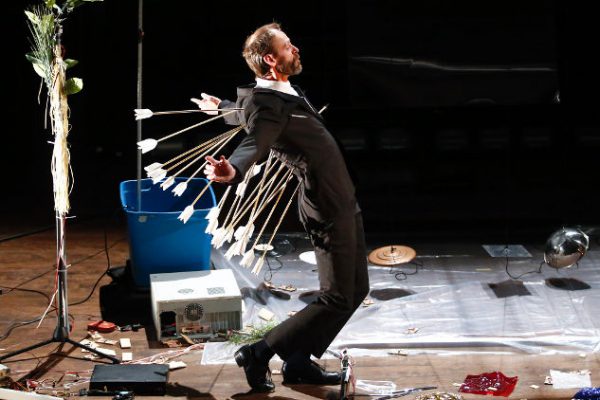Public Energy’s artist in residence Lara Kramer (of Montréal based Lara Kramer Danse) sits crouched, knees together, listening. Her three performers gently crowd around her, postures relaxed, faces intent. They’ve been working hard in Peterborough’s Market Hall, and now it’s time for rehearsal notes. I sit and watch quietly. Kramer gazes out over what looks to be a cross between a hoarder’s living room, and a student hovel that’s just been ransacked. She looks pensive. Strewn before her are piles and piles of stuff. A hair dryer, microwave, extension cords, Barbie dolls hanging by their necks, dishevelled couches, mounds of paper towel. This is the setting of Kramer’s newest work Tame.
Kramer and her collaborators are going over a section in Tame that’s not working. Performers Angie Cheng, Karina Iraola and Amélie Rajotte all have slightly different takes on the issue, and each weigh in. Continuously shifting between French and English, a revolving door of language, each balances the desire to accommodate each other with the need to express oneself clearly — the true art of collaboration. And what a fruitful collaboration it’s been. In 2013, Karina Iraola and Angie Cheng also performed in Kramer’s NGS (“Native Girl Syndrome”) which was met with critical acclaim.
The world premiere is in two days. Kramer listens carefully as her collaborators troubleshoot. Like her work, she is focussed, intuitive, and highly perceptive. A seasoned choreographer with five full-length works, a slew of residencies, and a company under her name, Kramer gracefully brings the discussion to a resolution. There is still more work to be done.
***
Victoria Mohr-Blakeney Tame teeters on the border between dance, theatre, and performance art; do these disciplinary boundaries help us access the work or do they become an obstacle?
Lara Kramer For me these disciplines are all interconnected in this work. They are not separate entities that direct a choice or inform a working structure. They are present as a result developing work where the choice for realism is on the forefront of creation. I like the idea of audience members not needing to understand the language of dance or history of performance art or reference to theatre. They simply connect or dislike a character, understand or detach from an experience, find pleasure and enjoyment in the story of Tame.
VMB Tame has some of the stylistic and structural elements of NGS (“Native Girl Syndrome”) how do you see the relationship between these two works?
LK Both works are anchored in the physicality of the body. The relationship to the internal state and vibration is what carries the life of the characters. Everything is felt and experienced through the physical impulses and reactions of the characters. The decor, textures and sound elements in both works are a part of the extension of the body. Structurally the work is carved by the value of duration of time that is felt and lived through the characters.
VMB You mention time and duration. Can you talk about how time functions in Tame?
LK I want the characters to live everything to its end and push the boundaries of what the end is of an idea, an intension, sensation, reaction, delayed response, confrontation … This reinforces a durational element. The function of that is in the hands of characters experience.
VMB Props and object filled sets play a crucial role in much of your work. Can you describe why this approach was so central in Tame?
LK It’s true that the work started with a large amount of material, set and props. The purpose was to overwhelm the dancers. As part of my initial research for Tame, the abundance of set pieces and objects became part of the process in navigating through what is the seed of the universe of Tame. I think the need for the objects, set in my work helps to build the tensions in the body, in space and in character development. There is a realism to my work … we are so often not in a space clear of material. The material is our everyday. I’m highlighting what is important to the characters at hand.
VMB What does it mean to you to develop Tame in a small community like Peterborough — how does this setting inform the work?
LK Peterborough has a very intimate and calming feel to it. I feel really grounded here. Being an artist in residence affords me the luxury of time and changes the manner in how I approach my work. This extra time to refine the material is reflected in the work.
VMB What were some of the greatest challenges you faced while creating Tame?
LK One of the biggest challenges I faced while creating Tame was having the creative process feel suspended or on hold due to personal or financial reasons. When a work has its natural course of life and is then interrupted, it’s the dormant period that can feel like a risk. It became a question of how much life experience do these characters need in order to grow, mature and become more grounded.
VMB After touring Tame, what’s next for you?
LK I’m going to be re-working, possibly re-creating NGS (“Native Girl Syndrome”) for performances in Montréal, Toronto and the United States. I’m hoping to have the opportunity to revisit the work deeply and push other elements in the work that were not addressed before. I’m also hoping to start research that links me back to my blood land in Ontario.
Tagged: Contemporary, Lara Kramer Danse, Physical Theatre, ON , Peterborough





